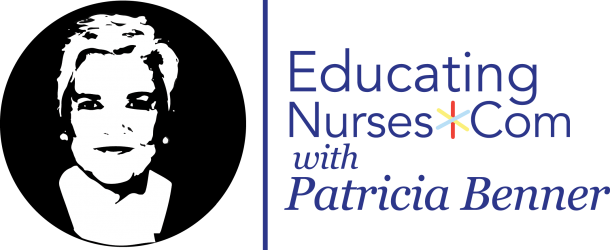The following Six Essential Lessons for entering the world of more interactive and learning focused teaching, demonstrates how to teach for situated thinking and active problem solving. These learning modules reflect the current focus on learning outcomes in teaching and learning, as well as the productive thinking required for situated knowledge use. Using knowledge productively in open-ended unstructured clinical situation is more than mere application of clinical knowledge. Using knowledge, such as contextualized interpretation of vital signs, requires more than applying techniques of measuring vital signs.
As a new nursing educator, it is hard not to focus on your own knowledge and how to convey that knowledge, but we encourage you to think about what is required for teaching a complex practice such as nursing. Learning to practice nursing requires that the student learn how to think like a nurse in open-ended clinical situations. We invite you to leave behind the image of the teacher as a sage on stage (a nervous-making image for anyone!) and adopt a co-adventure with students where the aim is to learn how to use the best, most relevant knowledge in clinical situations. It is never an absolute requirement that a teacher know more than his or her students, but they should be knowledgeable about what they are teaching (Bain, 2004). The teacher does well to model strategies for inquiry when asked a question that the teacher does not know. Confident inquiring and an ongoing demonstration of finding answers are essential. Saying “I don’t know the answer to that question, but let’s do some searching together” is essential. Using knowledge requires developing a sense of what is most and least important in clinical situations; we call this teaching for a sense of salience. All the master teachers you will observe in this module teach for a sense of salience in different ways. These lessons all illustrate the latest research on active learning, the role of engagement and puzzle solving for learning, as well as situated thinking and action required for entering a practice.
Highly effective teachers use various strategies, such as:
• the flipped classroom
• unfolding clinical cases
• the use of first person experience near-narratives of experiential learning
• the situated teaching of science to increase abilities to problem solve and use knowledge
in open ended clinical situations
Each teacher structures the classroom for a high level of interaction and problem solving.
The classroom is designed to help students use the knowledge that they are learning rather than being focused on information learning alone (memorization). You may want to study one video a week, so that you can think, try out, and read more on the pedagogical strategies that are being demonstrated by these master teachers. If you are fortunate enough to have other teachers who are interested in taking this journey of discovery with you, so much the better! Your group discussions about your own journey and experiential learning as a teacher will enrich one another. You will find that every video on this website emphasizes experiential learning that is contextualized in actual practice situations.
This collection of Six lessons for beginning teachers, and for teachers seeking to learn a more interactive style of teaching can also be taken for Continuing Education Credit. We have included in these lessons short articles on teaching.
April 7, 2014.

I enjoyed this module. I see a kinship in what I do in my professional practice as a NP and as an new educator. I still have the jov of nursing after 40 years in the healthcare field and each new adventure causes me to learn and grow. There is a resonance in the topics discussed because in the “real world” no one can know everything and healthcare providers rely on each other as a team to accomplish the goals. Patients are at the center of everything and they will do what they want not always what we tell them to do.
These concepts are discussed in a new way than when I went to nursing school and rote memorization was the norm. Now we are able to look up information on cell phones and other devices. I do have knowledge but may look up something to verify my ideas or thinking. When I explain to patients why medications are necessary and how they affect them they are more apt to take them. As an instructor The concepts in this presentation are more realistic. I will use what I have learned to change the classroom. Thanks
Wilma Lynne Cherry MSN APRN BC- FNP